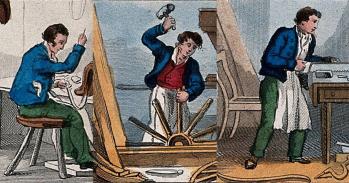The makers of the beef extract called Bovril were pioneers in the dark arts of marketing. Speaking tomorrow at the Oxford Symposium on Food & Cookery, Cambridge University historian Lesley Steinitz will show how that famous black gloop won a cherished place in the heart of the nation.
The makers of the beef extract called Bovril were pioneers in the dark arts of marketing. Speaking tomorrow at the Oxford Symposium on Food & Cookery, Cambridge University historian Lesley Steinitz will show how that famous black gloop won a cherished place in the heart of the nation.
Bovril slotted into the temperance movement as a drink that was alcohol-free but not namby-pamby. It has a dark, macho look and a meaty, macho smell.
Lesley Steinitz
A century and a half ago, a revolution took place in the food industry. A boom in the urban population fuelled a need for the mass production of affordable, non-perishable foodstuffs sold in cans and jars. Advances in processing and manufacturing collided with a burgeoning interest in science: the result was the emergence of branded convenience foods, cleverly marketed as nourishing and nutritious.
Speaking tomorrow at the Oxford Symposium on Food & Cookery, Lesley Steinitz will present a paper titled ‘Making Muscular Machines with Nitrogenous Nutrition: Bovril, Plasmon and Cadbury’s Cocoa’. In her discussion of what went into the building of these most stalwart of brands, Steinitz will address the question of how some of these products are so embedded in the public psyche that we go on buying them even when their grandiose claims have long been dropped.
Food is the stuff of life: the fortunes made in food manufacturing rely on the creation of narratives that tap into our deepest hopes and fears. The story of Bovril as the ultimate processed beef-based food is an example of brilliant marketing and myth-making – one that famously brings together notions of Britishness and beefiness into a bulbous bottle with a chunky red lid.
Some 130 years ago a Scotsman spotted a gap in the market. Tasked with supplying preserved beef from the ranches of North America for Napoleon III’s army, following their defeat due to starvation during the 1870/71 Siege of Paris, John Lawson Johnston saw the potential for a beef extract with added protein. He produced an extract made by heating carcasses of cattle and reducing the liquids that came off into a residue which was mixed with powdered dried meat. This substance, which Johnston believed was truly nutritious, overcame all the problems associated with the transportation of meat across thousands of miles of ocean.
 As a brand that for decades stood the test of time and still boasts iconic status in the public imagination, Bovril encapsulated notions of health and energy, stamina and stoicism. Bovril is good for you. It helps to build healthy bodies. Bovril is what explorers drink to keep their spirits up when times are tough. It’s what your British granny gives you to sip when you’re recovering from a bug. Bovril makes your Sunday roast gravy dark and strong.
As a brand that for decades stood the test of time and still boasts iconic status in the public imagination, Bovril encapsulated notions of health and energy, stamina and stoicism. Bovril is good for you. It helps to build healthy bodies. Bovril is what explorers drink to keep their spirits up when times are tough. It’s what your British granny gives you to sip when you’re recovering from a bug. Bovril makes your Sunday roast gravy dark and strong.
How did Johnston build his brand – and how did he create an image for a gloopy substance that has its own niche in the history of British food? Steinitz looks at the ways in which Johnston built a huge market for Bovril which is just one of the products covered by her wider study of industrial health foods and culture between 1880 and 1920. It was an era marked by a new decadence as an expanding sector of the population could afford new-style convenience foods while many worried about a reversal of Darwinian evolution towards the physical and moral degeneration of the human race, caused by the evils of industry, drink and squalor.
Steinitz explained: “The practice of dietetics, eating the appropriate food to make you well, was a practice which stretched back to ancient times. Advances in the application of scientific know-how – especially chemistry – and technology opened up new possibilities for food processing and preservation and its transportation across massive distances. Many of the new food products – which often didn’t resemble anything you could make at home - were attached onto older dietetic practices and were promoted not for just their convenience, cost or flavour, but also because they were health-giving. One such food was Bovril.”
Bovril was an inspired name marrying together meat, myth and magic: the first part of the word ‘bo’ borrowed from bovine and the second part ‘vril’ from Edward Bulwer-Lytton’s science fiction novel, The Coming Race, in which the Vril-ya were an underground people with awesome electrical powers.
“From the start, Bovril was heavily advertised through campaigns that tapped into the mood of the public quite brilliantly. It was British and the company worked hard to make sure it was a food of choice of the army – it was patriotic and nutritious. Advertising featured pictures of bulls: the strongest of beasts, whose meat turned British men into the strongest and smartest in Europe. Essentially Bovril was imagined as a bull in a bottle. In this way, the advertising of Bovril is strikingly different to the advertising of meat products today which rarely if ever carry images of animals,” said Steinitz.
Advertising connected Bovril to the fashionable and popular physical culture movement by getting sporting celebrities to endorse the brand. One of these, the world’s strongest man at the turn of the 20th century, an Adonis-like star called Eugen Sandow, had developed his rippling muscles so that his body resembled a classical sculpture which he showed off to enormous crowds in the music halls. In the 1910s Bovril was also marketed as a highly advanced, scientific beverage that had been shown in experiments to boost the weight, assumed to be muscle mass, of humans and dogs.
The scientific theories that surrounded Bovril linked it with electricity, another marvel of science that was changing people’s lives. “In the late Victorian era, there were many popular therapies that used electricity as a stimulant and tonic for nervous complaints and constipation,” said Steinitz. “Bovril also slotted into the temperance movement as a drink that was alcohol-free and yet not namby-pamby. It has a suitable dark, macho look and a meaty, macho smell.”
Advertising was only part of the story. The company needed to source beef extract and protein, which meant working with ranchers in South America and the Antipodes, with shipping lines and hundreds of retailers. It meant keeping the supply chain flowing to meet growing demand. In all these areas, the Bovril company was adept at building networks with people of influence. And on every level the company innovated, for example, purchasing machines and dynamos to automate the manufacture and packaging of up to 150,000 bottles of Bovril per day in Bovril’s state-of-the-art factory which opened in 1900 in the heart of London. Its directors were so proud of their factory that they hosted annual tours for doctors and nurses, of their ‘Temple of Sanitation'.
As Johnston used his commercial success and his newfound wealth to march up the social scale, he exploited his network of powerful contacts to generate orders for his product which went into the armed forces, hospitals and workhouses. This gave Bovril the credibility as a legitimate health food for people to buy it also for home use. Its markets crossed class boundaries and Bovril could be drunk any time of day or night. It could also be spread on toast or added to soups and stews. In the summer, the company tried to persuade consumers to drink it cold with soda!
The product did however hit a few blips: Bovril had its own horse-meat scandals during the late 1800s, and in 1906 sales of Bovril dipped as result of public horror at the appalling human and animal conditions in the massive Chicago meat processing plants exposed by the publication of Upton Sinclair’s bestselling novel, The Jungle. More recently Bovril went beef-free for a period in response to concerns about BSE (mad cow disease).
Where is Bovril today? It’s still on the supermarket shelves but in many homes the squat black bottle slumbers at the back of the kitchen cupboard. The brand is owned by food giant Unilever and sales tick over at a modest pace – and inflated scientific claims for Bovril’s health-giving properties have long disappeared. “While Bovril used to be marketed as British using symbolism of beef and a bull, today its advertising taps into Britishness as symbolised by the National Trust and energetic outdoor pursuits in all weathers. But there is still something unshakable about our belief in British backbone from tasty Bovril,” said Steinitz. The black pot with the red lid lives on.
For more information about this story contact Alex Buxton, Office of Communications, University of Cambridge, amb206@admin.cam.ac.uk, 01223 761673
Top inset image: John Lawson Johnston
This work is licensed under a Creative Commons Licence. If you use this content on your site please link back to this page.





